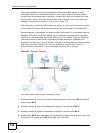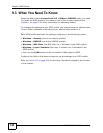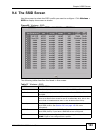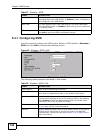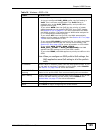
Chapter 8 Wireless Configuration
NWA-3500/NWA-3550 User’s Guide
138
reductions in data transmission for applications that are sensitive to latency
(delay) and jitter (variations in delay).
8.5.6.1 WMM QoS Priorities
The following table describes the WMM QoS priority levels that the NWA uses.
8.5.7 ATC
Automatic Traffic Classifier (ATC) is a bandwidth management tool that prioritizes
data packets sent across the network. ATC assigns each packet a priority and then
queues the packet accordingly. Packets assigned a high priority are processed
more quickly than those with low priority if there is congestion, allowing time-
sensitive applications to flow more smoothly. Time-sensitive applications include
both those that require a low level of latency and a low level of jitter such as Voice
over IP or Internet gaming, and those for which jitter alone is a problem such as
Internet radio or streaming video.
ATC assigns priority based on packet size, since time-sensitive applications such
as Internet telephony (Voice over IP or VoIP) tend to have smaller packet sizes
than non-time sensitive applications such as FTP (File Transfer Protocol). The
following table shows some common applications, their time sensitivity, and their
typical data packet sizes. Note that the figures given are merely examples - sizes
may differ according to application and circumstances.
Table 32 WMM QoS Priorities
PRIORITY LEVEL DESCRIPTION
voice
(WMM_VOICE)
Typically used for traffic that is especially sensitive to jitter. Use
this priority to reduce latency for improved voice quality.
video
(WMM_VIDEO)
Typically used for traffic which has some tolerance for jitter but
needs to be prioritized over other data traffic.
best effort
(WMM_BEST_EFFORT
)
Typically used for traffic from applications or devices that lack
QoS capabilities. Use best effort priority for traffic that is less
sensitive to latency, but is affected by long delays, such as
Internet surfing.
background
(WMM_BACKGROUND
)
This is typically used for non-critical traffic such as bulk transfers
and print jobs that are allowed but that should not affect other
applications and users. Use background priority for applications
that do not have strict latency and throughput requirements.
Table 33 Typical Packet Sizes
APPLICATION
TIME
SENSITIVITY
TYPICAL PACKET
SIZE (BYTES)
Voice over IP (SIP) High < 250
Online Gaming High 60 ~ 90







